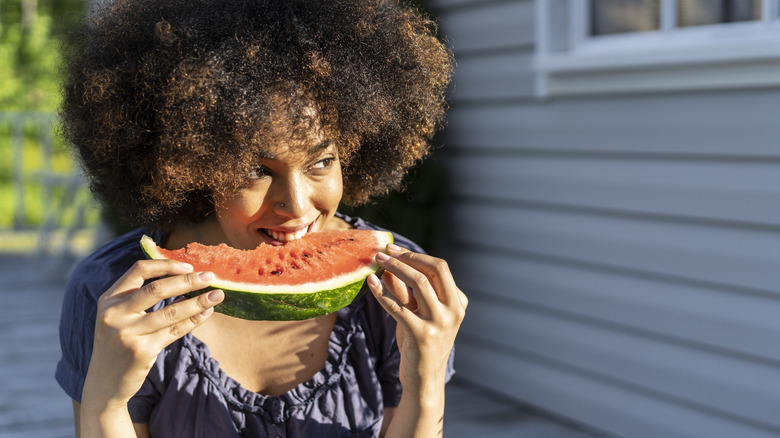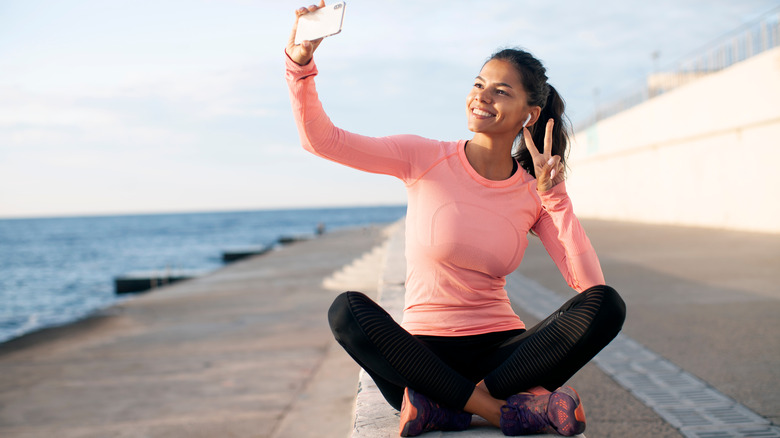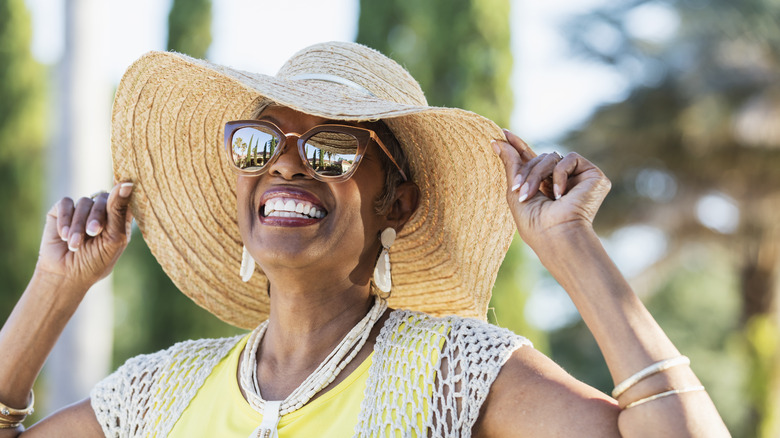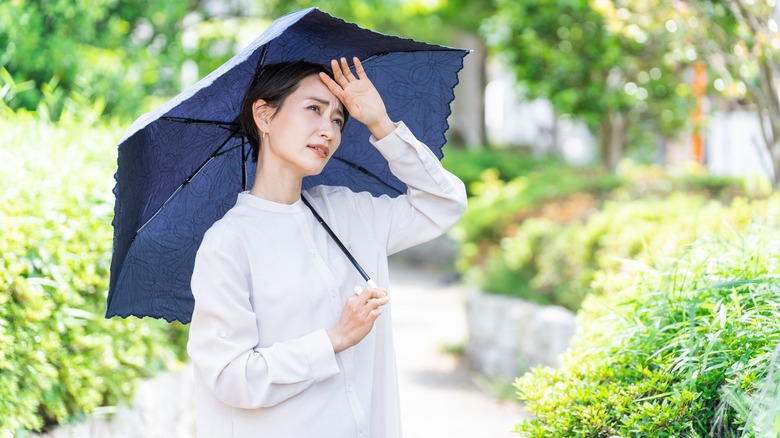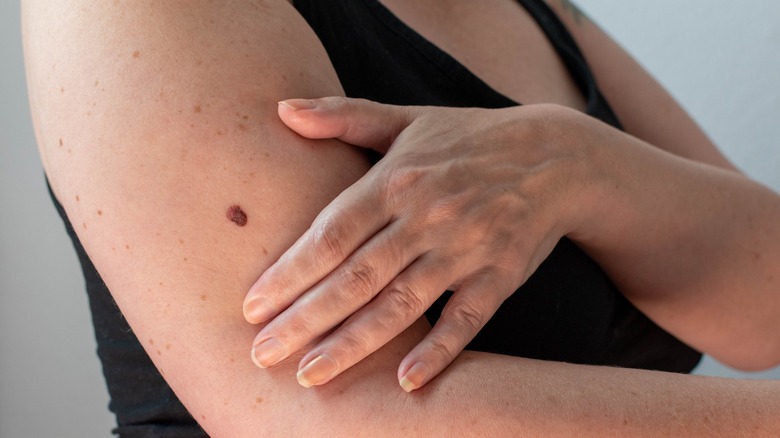5 Ways To Lower Risk Of Skin Cancer Outside Of Simply Wearing SPF
Summer is all about enjoying the warm weather, longer daylight hours, and rays of sunshine that bring an abundance of opportunities for fun in the sun. However, spending time in the sun can also increase the risk of developing skin cancer if proper precautions aren't taken to protect your body from the harsh effects of ultraviolet (UV) rays. You've probably heard examples of skin protection measures before, but it's important to put together a routine of daily habits to keep your skin thriving since – you know – you live in the same skin for your entire life.
In recent years, there's been significant chatter about the benefits of wearing sunscreen, but lesser known are the many other ways you can protect your skin and reduce your risk of skin cancer, including what you eat and even what you wear. That being said, when you spend time out in the sun, especially poolside or at the beach, there are some additional items you should toss in your bag to bring with you and practices to incorporate into your routine. Here's more of what you need in your skin protection toolkit.
Your diet can defend your skin
Applying sunscreen is a way to protect your skin by creating an outer barrier, but there are ways to protect your skin against harmful UV rays from the inside out. Through your diet, you can incorporate foods, vitamins, and nutrients with skin protective factors (SPF), and though it might sound odd to think about foods with SPF or to refer to antioxidants as being the equivalent of edible sunscreen, there is science backing the legitimacy of SPF diets, reports CNN. Antioxidants are a term you've likely heard before, and you may already eat items involving antioxidants, but this is your sign to stockpile antioxidant-rich foods into your diet. Essentially, antioxidants are nature's SPF as the compounds can create internal barriers when consumed through select foods, ultimately preventing the negative effects of free radicals and UV rays on the skin. From reducing wrinkles and signs of aging to absorbing dangerous cancer-causing components from the sun before they can sink into your skin, antioxidants you eat figuratively set up a command center inside of your body with the aim of keeping enemy forces, aka UV rays, at bay.
In particular, polyphenols and carotenoids are two types of antioxidants which specifically work to imbibe ultraviolet wavelengths before your body can absorb them. Alongside vitamins E and C, antioxidants like carotenoids and polyphenols are found in blueberries, carrots, watermelon, and cauliflower, among others, per Healthline. For a super SPF sipping selection, green tea is practically drinkable sunscreen.
Expand your wardrobe with conscious choices
If you've been looking for an excuse to buy new clothes, you have a valid reason in the name of sun protection. Though, be intentional with your new attire and make conscious choices that prioritize lowering your risk of developing skin cancer. Before buying the cute outfit you've been eyeing, do your research to see if there are options available labeled with ultraviolet protection factor (UPF) values, recommends Skin Cancer Foundation. Clothing with UPF markers, aka fashion's sunscreen, can block both UVA and UVB rays, the two types of ultraviolet rays that can reach the human body and instigate skin cancers.
SPF values on sunscreen inform the consumer of how long the sun protection lasts, hence why sunscreen must be reapplied a minimum of every two hours, as per the EPA. Conversely, UPF values signal the percentage of UV rays blocked by the fabric of a given piece of clothing. According to Sungrubbies, optimal fabric markers are considered to be UPF 40 and above, with UPF 50 or 50+ being the highest rating, as respective clothing can revoke a minimum of 97.5% of harmful cancer-causing UV rays. Try to search for clothing labeled at least UPF 15, but whether you opt for UPF or non-UPF specific garments, the best sun protection comes from loose-fitting clothing made from tightly sewn fabrics, including denim. The more colorful the clothing, the better sun protection, as brighter and darker dyes are more effective in preventing skin cancer.
Hats on heads and glasses on faces
Continuing along the lines of fashionable sun protection, you can further protect your body from skin cancers by appropriately accessorizing. Just like with wardrobe staples with UPF values that protect the skin covered by respective garments, thus a reminder to wear long sleeves and pants whenever possible, you'll want to prioritize protecting as much of your body as possible. This includes your head, face, shoulders, and even your eyes.
Yes, skin cancers can develop in and around your eyes. The folds of skin on your eyelids and surrounding area can be sensitive and subsequently susceptible to sunlight absorption, says Mayo Clinic. This is why wearing sunglasses every time you go outside is imperative for your health, not merely to prevent the discomfort of overly-aggressive glares from vibrant sunshine. Similar to clothing, sunglasses with UV-repelling features are frequently found with labels explicitly stating protection from ultraviolet rays, sometimes indicating safeguarding from both UVA and UVB rays. However, a label akin to 'broad spectrum coverage' also references elements that armor against dangerous sunlight.
Another essential accessory to have with you is a hat. While any hat is better than no hat, a wide-brimmed hat is the best option as it provides the most shading of your head, ears, and shoulders. It's never too early to begin wearing protective fashion. Children are also encouraged to wear broad-coverage sunglasses, hats, and UPF clothing when outdoors.
Seek solace in shaded spaces
During the summer months, the sun's rays are harshest than other times of the year, with intense exposure occurring near bodies of water, on sandy beaches, and in the middle of the day. Specifically, sunlight and UV ray exposure are concentrated between the hours of 10 a.m. and 4 p.m. regardless of geographical location or time zone, states MedStar Health. If possible, avoid going outside during these hours, no matter the season of the year.
Should venturing outdoors be necessary, a critical habit to cultivate is searching for spots of shade and seeking solace with as much sun-blocking overhead coverage as possible. Cancer Institute NSW provides an easy hack for determining the UV-repellent quality of shade, whether natural shade from a tree or artificial shade from a constructed awning or playground cover, by taking stock of the extent of blue sky peering through the entity providing shade. The higher quality of a shaded space, the less sky you'll be able to view when looking straight above.
You can be crafty by bringing along your own shade coverage when you go outside. When spending extended time outside, pack a cover that can easily be set up for temporary shade, suggests GoodRx Health. While walking in sunlight, utilize an umbrella for mobile shade or take the opportunity to indulge in Regencycore with an old-fashioned parasol.
Conduct regular skin screenings
Establish a habit of routine skin checks to catch signs of potential skin cancer early on. Document changes to your skin, specifically when it comes to moles. Cleveland Clinic advises assessing moles using the ABCDE criteria, which can indicate abnormal moles if they're asymmetrical in appearance, have uneven borders, contain multiple colors or unusual hues, have diameters greater than the size of a pencil eraser, and/or are elevated in texture rather than flat.
MedlinePlus recommends performing regular self-exams on your body, from the top of your head to both of your smallest toes. Begin with your scalp by parting a small amount of hair to examine the skin beneath your locks, accepting the help of a blow dryer for ease of moving hair around. Always perform self-exams in spaces with bright lighting and utilize the assistance of a full-length mirror for checking areas of your body difficult to view on your own. Some places may not seem obvious to check, like folds of skin within armpits, beneath breasts, and on the bottoms of feet. Look at the skin between each finger and toe, then remove nail polish to inspect the skin under each of your nails. Awkwardness aside, it's vital to inspect all angles of your genitalia and intimate areas, including between your buttocks. Lastly, seek an annual full-body screening by a dermatologist for the added benefit of their trained eye for spotting signs of skin cancer you may not be able to catch yourself.

